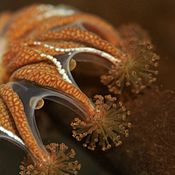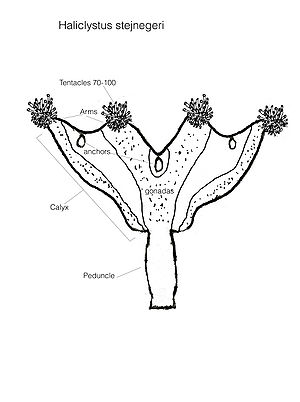Haliclystus stejnegeri
From marinelife1011
Contents |
Haliclystus stejnegeri
| Haliclystus stejnegeri | |
|---|---|
 |
|
| Haliclystus stejnegeri photo taken by Minette Layne[1] | |
| Scientific classification | |
| Kingdom: | Animalia |
| Phylum: | Cnidaria |
| Class: | Staurozoa |
| Order: | Stauromedusae |
| Family: | Lucernariidae |
| Genus: | Haliclystus |
| Species: | H. stejnegeri |
| Binomial name | |
| Haliclystus stejnegeri Kishinouye, 1899 |
|
Haliclystus stejnegeri belongs to the order Stauromedusae, the stalked jellyfish. Unlike other jellyfish Stauromedusae do not rythmically pulse but stay in a sessile polyp form for most of thier life and lack a pelagic phase. H.stejneger attaches to the substrate using adhesive fibers formed from substances secreted from its basal disc.[2] It is bilaterally symmetrical with eight arms and eight gonads. It is most commonly found attached to eelgrass or seaweed in low intertidal habitats. H.stejnegeri can be distinguished from other species by the four interradial white stripes and the shape of the anchors.[3]
Description
H. stejnegri has a funnel shaped calyx generally around 10-12 mm wide, with a relatively short peduncle around 7-8 mm long.[4] The exumbrella is smooth and fairly unresponsive but the subumbrella is extremely sensitive to outside stimuli.[5] It possesses eight arms, each tipped with a cluster of tentacles used for feeding and for holding on to the substrate should it become dislodged. The eight marginal anchors between the arms are believed to be used in mobility through a somersault like motion.[6] It can come in a variety of colors ranging from reddish brown, orange to yellow and green varying with the environment.[7]
Range
North Pacific, Alaska to Puget sound, and the Bearing Sea to Japan
Reproduction
H. stejnegeri possesses eight gonads that run along the arms on internal side of the umbrella containing 100-150 sacs each. The larvae are planulae that move by creeping along the substrate. The planulae are believed to encyst (enclose themselves) for months before reemerging as polyps. [8]
Feeding
H. stejnegeri's eight arms are equipped with a cluster of 70-100 tentacles tipped with a knob of nematocysts which it uses to catch prey. The subumbrella also has clusters of nematocysts along the radial edges which may help in feeding. Their diet consists primarily of the amphipod Caprella. [9]
References
- ↑ http://commons.wikimedia.org/wiki/File:Haliclystus_stejnegeri_1.jpg#globalusage
- ↑ C.L. Singla, Ultrastucture and Attachment of the Basal Disk of Haliclystus, Springer vol. 1, 533-540}}
- ↑ Uchida, T., & Hanaoka K-I. (1934). Anatomy of two stalked medusae with remarks on the distribution of the Stauromedusae in Japan. Journal of the Faculty of Science, Hokkaido Imperial University, Series VI. Zoology. 2(4), 211-239.}}
- ↑ Uchida, T., & Hanaoka K-I. (1934). Anatomy of two stalked medusae with remarks on the distribution of the Stauromedusae in Japan. Journal of the Faculty of Science, Hokkaido Imperial University, Series VI. Zoology. 2(4), 211-239.]]
- ↑ G. F. Gwilliam, (1960), Physiology of a Sessile Scyphozoan, Biological Bulletin, Vol. 119, No. 3 pp. 454-473.
- ↑ http://faculty.washington.edu/cemills/Stauromedusae.html
- ↑ http://www.wallawalla.edu/academics/departments/biology/rosario/inverts/Cnidaria/Class-Scyphozoa/Order-Stauromedusae/Haliclystus_stegnegeri.html]]
- ↑ Mills C.E., Hirano Y.M., (2007). Encyclopedia of tidepools and rocky shores, University of California Press, 541-543}}
- ↑ Libbie H. Hyman, (1940) Observations and Experiments on the Physiology of Medusae, Biological Bulletin, Vol. 79, No. 2, pp. 282-296

